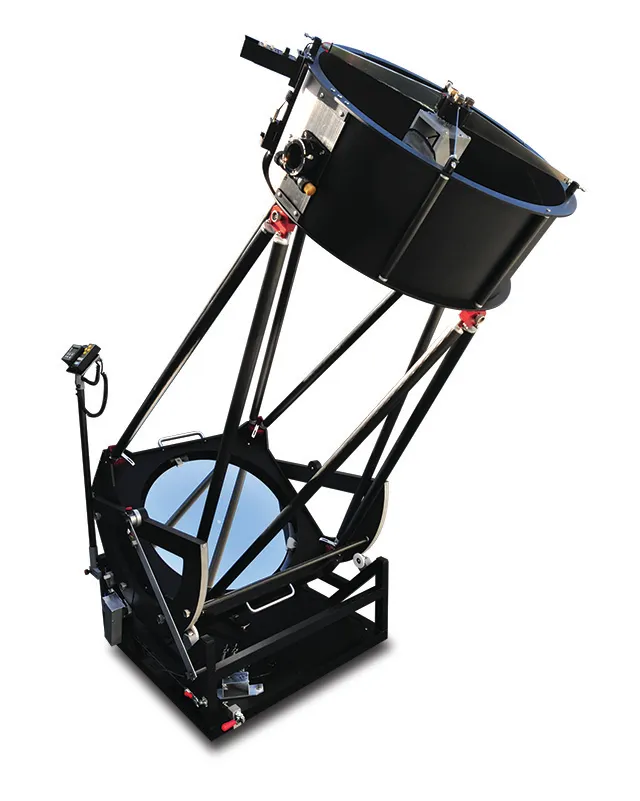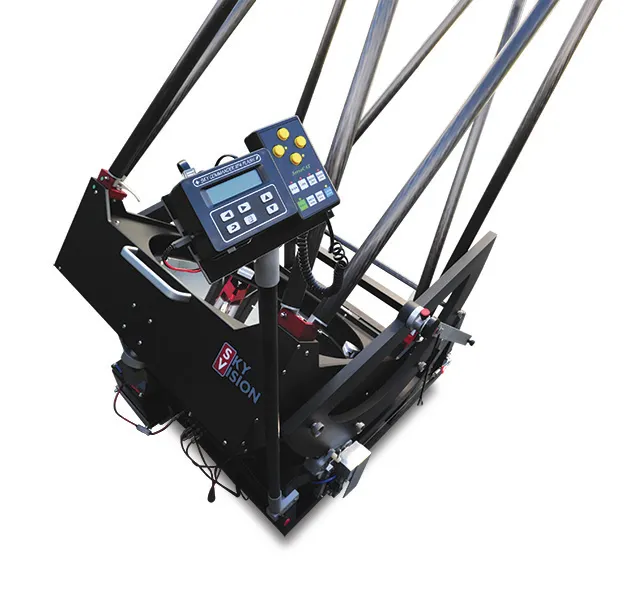Price: £1999.99
Aperture: 600mm
Focal Length: 1980mm (f/3.3)
Weight: 99kg
Supplier: Altair Astro
Telephone: 01263 731505
Website: www.altairastro.com
If you want the finest deep-sky views, you need large, photon-grabbing optics of a high quality.
The SkyVision T600 Compact Dobsonian with its whopping 24-inch diameter mirror is that big aperture telescope.
It can be broken into manageable parts that fit into a family car, allowing you to travel away from city lights to get the very best views of the heavens.
The instrument also has full Go-To capability and motorised tracking to further enhance your observing experience.
Even a cursory look at this telescope shows it clearly to be a beautiful and elegant piece of engineering, and you can see a huge amount of thought and effort has gone into its design and construction.
The scope comes in four main parts: a rocker box, primary box, truss pole set and secondary cage.
The heaviest and largest part by far is the primary box, which contains the 36kg main mirror, onto which the large horseshoe-shaped altitude bearings are attached.

This part weighs in at a hefty 69kg and needs to be carefully lowered into the rocker box – definitely a two-person operation.
After attaching the linked truss pole set to the corners of the primary box with four quick-release levers, we were ready to mount the secondary cage on top of the poles.
This item is a much more reasonable weight, and there are handy ledges to rest the cage on before securing the catches, so it is easy enough to do alone.
After removing the lightweight primary cover and fitting the Lycra shroud, the scope needed a small tweak using a laser collimator and the centre spotted mirror.
We could have started observing right then, but chose to use the full Go-To capability by aligning on two bright stars and engaging the azimuth and altitude motor clutches.
We then used the Sky Commander unit to drive the scope to a number of deep-sky objects. Each object was well within the field of a 6mm Ethos eyepiece, a testament to the quality of the Go-To system.
Tracking showed no signs of slippage or stalling, which can be a problem with driven large-aperture Dobsonians. However, we did witness objects slowly drifting from the centre of the field.
This was subsequently traced to an incorrect latitude setting, which was still set to that of SkyVison headquarters near Bordeaux.
Touring the sky with Go-To
The first object we viewed was the Ring Nebula, high overhead, which was big and bright in the 6mm eyepiece.
Using the same eyepiece we turned to M13 and M15, two of the finest globular clusters in the sky, which were easily resolved to their cores.
Another memorable view was the Dumbbell Nebula, which we glimpsed through a binoviewer and a pair of 24mm Panotic eyepieces.
The nebula had a mesmerising 3D appearance and was truly wonderful.
With this setup we moved on to the Blue Snowball planetary nebula, which showed clear inner structure even at this low magnification.
We followed our deep-sky viewing with some star testing, which showed smooth optics but signs of minor overcorrection – this may have disappeared with further cooling of the primary mirror.
The secondary mirror is quite exposed at the top of the secondary cage, and this led to it dewing up part of the way through our observing session. To drive off the dew we had to warm it up using the mirror’s 12V rear heater.
A lightweight extension to the top of the secondary cage might have helped delay such dewing – and if fitted opposite the eyepiece would also have blocked extraneous light reaching the eyepiece from the sky behind the secondary mirror.
A significant portion of sky can be seen with the eyepiece removed. Such direct light could reduce field contrast if a bright object were to rest in this area of the sky.
All in all the SkyVision T600 is an advanced scope for serious visual observers and delivers great performance in a beautifully crafted instrument that is a joy to look at and a pleasure to use.
Go-To capability and Tracking

The usefulness of a scope of this size is dramatically improved by the use of digital setting circles along with a good motorised system to slew to objects and keep them in the field of view.
The SkyVision T600 has a StellarCAT Go-To motor system married to a Sky Commander unit, although other digital setting circles such as ArgoNavis can be used instead.
The success of any such system on a big Dobsonian telescope is dependent on the degree of care taken in the design, in particular the mechanics linking the motors to the scope and the control of the friction in the altitude and azimuth bearings.
The whole drive system has been very well designed and manufactured so when engaged the drive system works without slipping with minimal backlash.
When disengaged, the scope can be easily and smoothly pushed to targets like a conventional, undriven Dobsonian.
In this manual mode the encoders stay linked so that you don’t lose alignment and you can re-engage the motors at any time.
Focuser
The choice of focuser is one of the decisions to be made at time of purchase, but the default option is a Starlight Feather Touch with normal and slow speed knobs. The beautiful engineering on this focuser complements that of the rest of the telescope.
Truss poles
The carbon fibre truss poles are a work of art in themselves and exemplify the attention to detail present throughout the instrument. Each is 27mm in diameter and they link together in a single expandable set, which readily locks into position with quick-release levers.
Thermal management
The large mirror contains a lot of glass, so to help it acclimatise to night-time temperature there are two 100mm fans in the side of the mirror box. These blow ambient air onto the side and underside of the mirror to cool it down.
Bearings
The azimuth bearings are PTFE pads riding on FRP glass board, a standard combination for many large-aperture Dobsonians. The altitude bearings are quite different and are special rollers with a friction preload originally designed for CNC machine tools.
Optics
The 24-inch primary mirror is made of low-expansion Suprax glass and possesses high reflectivity coatings. The mirror sits on an 18-point support cell and is beautifully finished with no visible streaks plus a perfectly ground edge bevel. The telescope has a short focal ratio of f/3.3 to keep the eyepiece height low.
This review originally appeared in the December 2015 issue of BBC Sky at Night Magazine.
